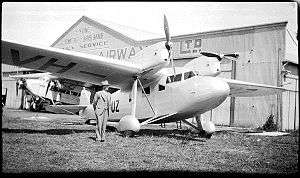Tugan Gannet
| LJW7 Gannet | |
|---|---|
 | |
| Role | Airliner |
| National origin | Australia |
| Manufacturer | Tugan Aircraft |
| Designer | Lawrence Wackett |
| First flight | 1935 |
| Number built | 8 |
| Developed from | Cockatoo Dockyard Codock |
The Tugan LJW7 Gannet, also known later as the Wackett Gannet after its designer Lawrence Wackett, was a small twin-engined airliner built by Tugan Aircraft in Australia in the 1930s.[1][2] It was the first Australian-designed aircraft to enter series production. It was also the first Australian-designed and built aircraft to be taken on strength by the Royal Australian Air Force.
Design and development
The Gannet was a strut-braced, high-wing monoplane of conventional design, with twin engines mounted in nacelles on the wings. The undercarriage was of fixed, tailwheel configuration with divided main units. The wings were of wooden construction, skinned in plywood, and the fuselage was built from welded steel covered in fabric.[1] The prototype Gannet underwent flight testing in October 1935, and was destroyed in a crash shortly thereafter.[3] The pilot and passengers perished in the ensuing fire,[3] but despite this, the Gannet entered series production.
The type was operated by Butler Air Transport between Sydney and Broken Hill[1] and at least one flew with Ansett Airways in 1943.[4] RAAF Gannets saw service as survey aircraft[5] between 1935 and 1942 when they were converted into air ambulances for the newly-formed No.2 Air Ambulance Unit.[6] The last RAAF Gannets were scrapped in 1946.[6]
Operators
- Ansett Airways
- Butler Air Transport
- Royal Australian Air Force
- Western and Southern Provincial Airlines
Specifications
Data from "A14 Wackett Gannet"
General characteristics
- Crew: one pilot
- Capacity: six passengers
- Length: 10.51 m (34 ft 6 in)
- Wingspan: 15.85 m (52 ft 0 in)
- Height: 3.50 m (11 ft 6 in)
- Empty weight: 1,470 kg (3,234 lb)
- Gross weight: 2,449 kg (5,388 lb)
- Powerplant: 2 × de Havilland Gipsy Six, 150 kW (200 hp) each
Performance
- Maximum speed: 240 km/h (150 mph)
- Range: 885 km (553 miles)
- Service ceiling: 17,000 m (5,200 ft)
- Rate of climb: 4.3 m/s (850 ft/min)
See also
- Related lists
Notes
References
- "A14 Wackett Gannet". RAAF Museum Point Cook. Retrieved 2009-02-21.
- Australian Academy of Technological Sciences and Engineering (1988). Technology in Australia 1788-1988. Parkville, Victoria: Australian Science and Technology Heritage Centre. ISBN 0-908029-49-7.
- "Australia's First Airliner". Flight: 678. 18 May 1961. Retrieved 2009-02-21.
- Mattingley, Christobel (October 2007). "Not Without Adversity" (PDF). National Library of Australia News. pp. 8–11. Retrieved 2009-02-21.
- Watkins, John L. (4 May 1961). "Australia's First Airliner". Flight International: 600. Retrieved 2009-02-21.
- Wilson, David (2006). The Brotherhood of Airmen. Sydney: Allen & Unwin. ISBN 1-74114-333-0.